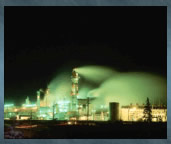
 Vinyl Chloride Vinyl Chloride
Vinyl chloride is a colorless, flammable gas with a mild, sweet odor. It is used to make plastics, including polyvinyl chloride ("PVC") plastic. PVC is used to make a variety of plastic products, including pipes, wire and cable coatings, and furniture upholstery. Vinyl chloride production has almost doubled over the last 20 years and is currently estimated at around 27 million tons per year worldwide. It is listed as one of top 50 most produced chemicals in the world. Vinyl chloride has been found in at least 496 of the 1,430 National Priorities List sites identified by the Environmental Protection Agency (EPA).
A Known Human Carcinogen
The U.S. Department of Health and Human Services, along numerous private organizations and physicians, have determined that vinyl chloride is a human carcinogen, i.e., a substance that causes cancer in humans. Acute (short-term) exposure to high levels of vinyl chloride effects the central nervous system causing dizziness, headaches, giddiness, unconsciousness, and even death. Chronic (long-term) exposure harms the liver, lungs, brain, and other blood forming organs. It has been shown to cause angiosarcoma of the liver. It has also been linked to glioblastoma, astrocytoma, Reynaud's Syndrome, brain cancer, pancreatic cancer, lymphoma, and other cancers. Chronic exposure has also been shown to cause problems with blood flow in the hands with associated bone degeneration and where the tips of the fingers turn white and hurt and bone degeneration is seen (known as acroosteolysis).
The Chemical Industry
Exposure to vinyl chloride occurs primarily in the workplace (although it has also been found in landfill gas and groundwater as a result of degradation of chloroethylene solvents). Hairdressers and beauticians are also at risk for developing angiosarcoma. Prior to 1974, hairsprays contained a significant amount of vinyl chloride. Vinyl chloride was originally thought only to be an explosion hazard and intoxicant. Chemical manufacturers allege that they only recently became aware of the dangers of vinyl chloride. However, the evidence indicates that certain chemical manufacturers not only knew about the dangers of vinyl chloride as early as the 1950's, but that they also took steps to conceal evidence of its toxic effects from their workers. As a result, certain manufacturers exposed at least two generations of workers to excessive levels of vinyl chloride. The evidence is only now surfacing because cancer caused by vinyl chloride exposure have taken years to manifest itself in older workers.
Legal Help
The Steinberg Law Firm is investigating vinyl chloride claims. Please contact us for a free legal, no obligation consultation.
Please e-mail Andrew E. Steinberg* at: andrewsteinberg@lawyer.com for a no cost, no obligation, and confidential consultation. Or call us at 713-529-0025.
*Not Certified by the Texas Board of Legal Specialization.
|